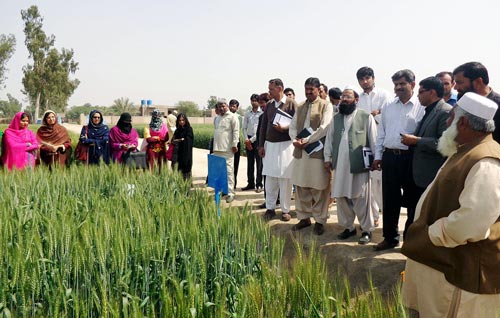By Imtiaz Hussain/CIMMYT
CIMMYT and the Department of Agriculture Research, Punjab, held a one-day training for agriculture extension workers in Bahawalpur, Pakistan, to share information, promote collaboration and encourage the dissemination of technologies from the USAID-Feed the Future funded Agriculture Innovation Program (AIP).
Held at the Regional Agriculture Research Institute (RARI) on 10 March, the training was attended by 28 workers from the Department of Agriculture Extension, Punjab, and 22 students from the University College of Agriculture and Environmental Sciences, Islamia University of Bahawalpur (IUB). Ghulam Hussain, director of RARI, lauded CIMMYT and USAID efforts in strengthening agriculture research in the country, especially in southern Punjab.

RARI’s Manzoor Hussain highlighted the institute’s efforts to develop wheat varieties for southern Punjab. He also emphasized the collaboration between research and agriculture extension. Imtiaz Hussain, CIMMYT cropping system agronomist, briefed the participants about AIP activities and shared conservation agronomy experience in Pakistan’s different cropping systems. Muhammad Akhter, from the Agronomic Research Station (ARS), Bahawalpur, presented on relay cropping of wheat in standing cotton. This technique allows farmers to plant wheat on time without land preparation and save on cultivation costs. Liaqat Ali explained the method of ridge planting for wheat, which involves land preparation, shallow tillage with cultivators and the use of ridgers to make ridges and furrows. Ridge planting can help farmers achieve 10 percent higher wheat grain yields and 30 to 40 percent savings in water over traditional techniques.
Tanveer Ahmed, executive director of Agriculture Extension, Bahawalpur, praised the collaboration between agriculture extension and research for technology transfer to farmers. After the seminar, participants visited field trials and demonstrations at RARI and ARS, Bahawalpur. Field demonstrations included information about salient characteristics of wheat varieties including Fareed-06, Maraj-08 and Aas-11, performance of wheat varieties in early and late planting, the balanced use of nutrients for wheat crops, relay cropping of wheat in standing cotton on flat and beds and ridge planting of wheat. During the field visit, researchers explained the methodologies of field technologies and answered questions. Participants from the extension department said these activities should be continued in the future to improve links between research and extension.
 Capacity development
Capacity development